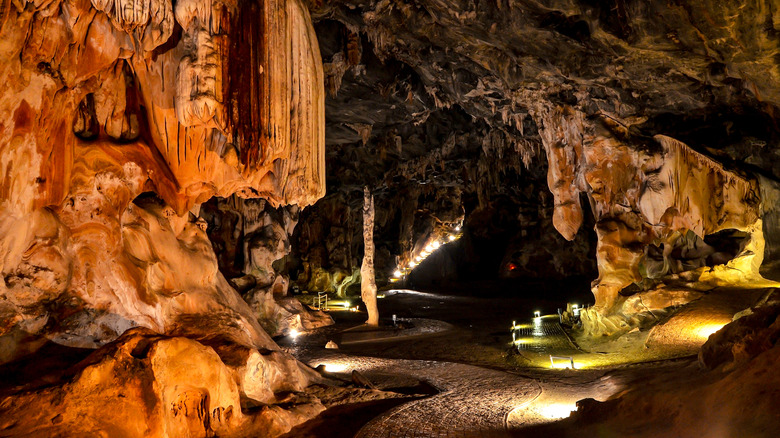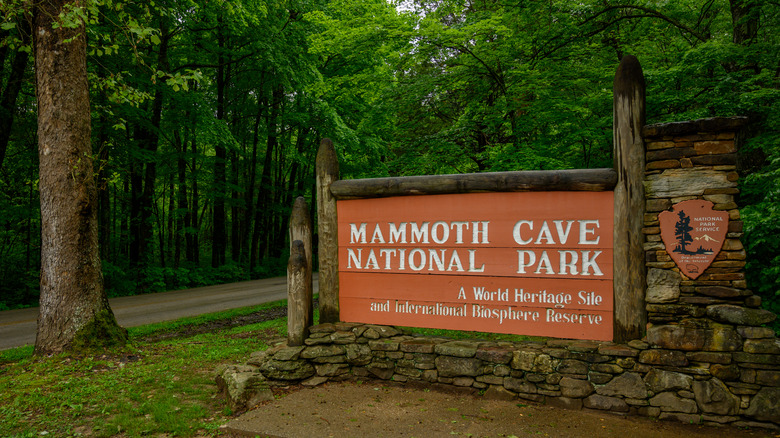This Is How Mammoth Cave Was Discovered
For those who've never heard of Mammoth Cave in Kentucky: No, there aren't any prehistoric wooly mammoths roaming the interior. That's not how it got its name. It is, however, really, really big, i.e., mammoth, gargantuan, behemothic, titanic, colossal, and other sorts of tasty adjectives. In fact, it's the longest cave system in the entire world, as the U.S. Department of the Interior explains, at 400 miles of twisted, sprawling corridors — that's longer than the distance from New York City to Pittsburgh. And, it might contain an additional 600 miles of corridors, although no one's gotten around to charting it in their spare time. If true, that would make Mammoth Cave one single connected cave system longer than the distance from New York to St. Louis. Plus, there are 200 whole additional side caves adjacent to the whole system. In other words: don't get lost inside, okay?
So if Mammoth Cave is so mammoth, how did it go unnoticed for so long (aside from being underground)? The truth is that it didn't. Cherokee, Shawnee, and Chickasaw tribes knew about it for at least 5,000 years. RV Share says that mummified remains of tribespeople have been found in the cave dating back to 3,000 B.C.E. Much, much more recently in 1797 C.E., we've got one of two local brothers — John or Francis Houchin — to thank for accidentally stumbling across the cave's entrance while hunting, per Heritage Daily. A Houchin brother pursued a wounded bear right to the entrance.
100 million years of creation
In geological terms, humans stumbled across Mammoth Cave last Tuesday. UNESCO says that the cave system took about 100 million years to form, and is extremely varied and rich in its design, composition, and materials. There are gigantic horizontal and vertical chambers, stalagmites and stalactites, gypsum formations (a type of mineral), and over 130 different subterranean plant and animal species, and the whole site is a magnificent example of "karst." Per the National Park Service, karst landscapes are composed of interconnected networks of aboveground and underground topography characterized by sinkholes, sunken bedrock, springs, caves, underground rivers, etc. Because of this, Mammoth Cave creates a portrait of Earth's geological history over time.
As for the folks who discovered it, we mentioned that various Native American tribes used it at least 5,000 years ago. By 1,200 B.C.E. they used mussels from the nearby Green River for mining purposes to scrape gypsum and other minerals off the cave walls, as the National Park Service says. They left behind torches made of bundles of river cane, woven sandals, bowls, petroglyphic cave art, and more. After one of the Houchin brothers found the entrance in 1797, the cave received its first registered survey in 1798, was sold in 1812 for industrial mining purposes, and became a tourist attraction by 1838, per Heritage Daily. More Than Just Parks says that Mammoth Cave became a U.S. national park in 1941, then in 1981 it became a UNESCO World Heritage Site, and in 1990 it was designated as a UNESCO International Biosphere Reserve.
2 million visitors per year
Nowadays, Mammoth Cave is as far from unknown and undiscovered as possible. More Than Just Parks says the site receives a whopping 2 million visitors per year with 500,000 of them taking a guided tour. The National Park Service confirms that at certain times you can indeed take a "discovery tour" (self-guided), but there are lots of rules for safety purposes. You can't bumble into the cave like one of the Houchin brothers over 200 years ago, but you can enter through that same "Historic Entrance" provided it's from 10 a.m. to 2 p.m. in June and July — that's it.
There are loads of other tours available, though — both aboveground and underground — with cool names like Great Onyx Lantern Tour, Violet City Lantern Tour, River Styx Cave Tour, Star Chamber Lantern Tour, and Domes & Dripstones Tour. The Wild Cave Tour is by far the most physically challenging, as it's an all-day spelunking adventure that requires crawling, climbing, and the use of specific footgear. All in all, the Native American tribes who once lived nearby might find it amusing to see modern people take whole trips and pay money to hang out in a dark, dank, underground place that they used for raw materials and where they used to house their dead.
Kentucky Tourism says that it's free to enter the nearby camping grounds. Visitors can hike, fish, canoe, ride horses, and more. There's even lodging right on the grounds for folks who want to stay overnight.


